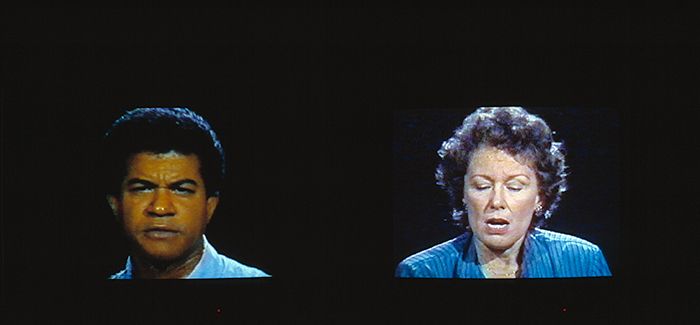Good Boy, Bad Boy
Bruce Nauman
Salt Galata
February 11 – March 2, 2014

Courtesy collection M HKA, Antwerp
SALT Galata, Floor 1
Bruce Nauman
Good Boy, Bad Boy (1985)
2 channel video
English without subtitles
Tape I (male): 60’ (loop)
Tape II (female): 52’ (loop)
Bruce Nauman created Good Boy, Bad Boy (1985) after a twelve-year pause in his video work. Two professional actors are given the task of repeating the same hundred sentences for five consecutive renditions. The actors change their pronunciation at each repetition, from neutral recitations to extremely emotional readings. The “I-you-we”-format, (I HATE, YOU HATE, WE HATE) is usually followed by a “this is”-phrase: THIS IS HATE. And though sometimes the ‘this-is’ seems like an explanation of the previous three, it is not always the case. At times, some of the fourth sentences defy all logic.
In this installation Bruce Nauman investigates the immunity of words; words usually contain more than one single, simple meaning. If we take the word “pain,” for example, the experience of pain is different for every individual. “Pain” can’t describe, in a general sense, personal feelings and sensations. Gradually the meaning of words loses power and can lead to an isolation of the experience. With this, Nauman refers to the philosopher Ludwig Wittgenstein, who maintained that there is no unanimity as to what language describes. The consensus upon which our language rests is false. Wittgenstein calls the very basis of language into question, and so our belief in language as well. Nauman, on the other hand, uses language not just as a matter of investigation, but also in the attempt to bring language and experience together.
Because of the difference between the actors’ speech tempo and the different running-times of the tapes, the texts shift in an endless stream of words. The content of the sentences is ideal and existential in nature: sexuality, death, work and elementary activities, at once intimate and impersonal. The schematic rhythm of the sentences evokes associations of speech exercises and school recitations, but also of indoctrination and brainwashing.
Source: Adapted from text on M HKA website.
Since the mid-1960s Bruce Nauman (b.1941) has experimented with sculpture, performance and video. Building on Marcel Duchamp’s ideas, he works from the conviction that everything happening in the studio can be art. This led to a series of short films and videos based on repetitive gestures. In later works the scope broadens, but Nauman continues to explore and exploit the myths surrounding artistic creation. One example is an early neon work with spiralling text that states: “The true artist helps the world by revealing mystic truths.”

